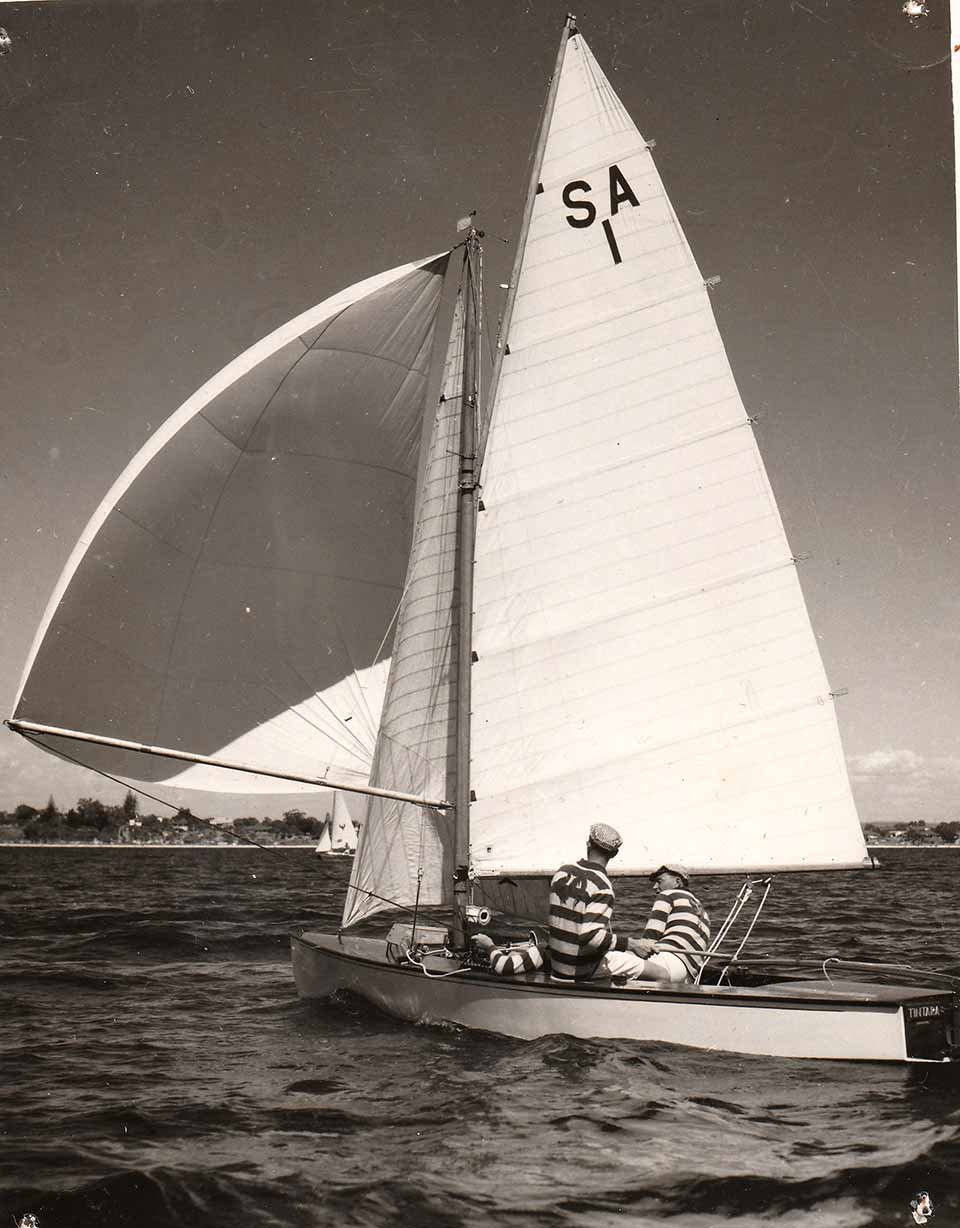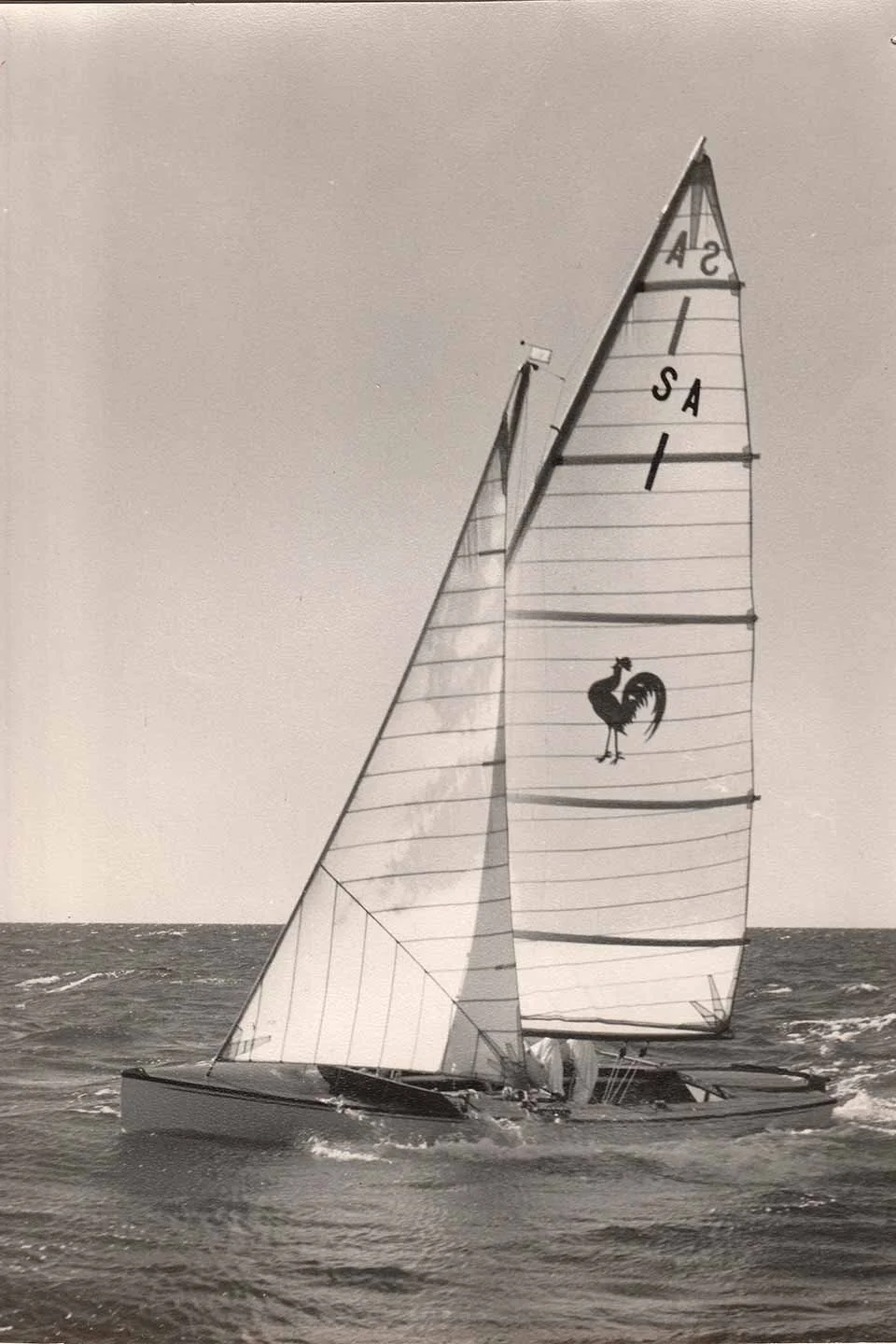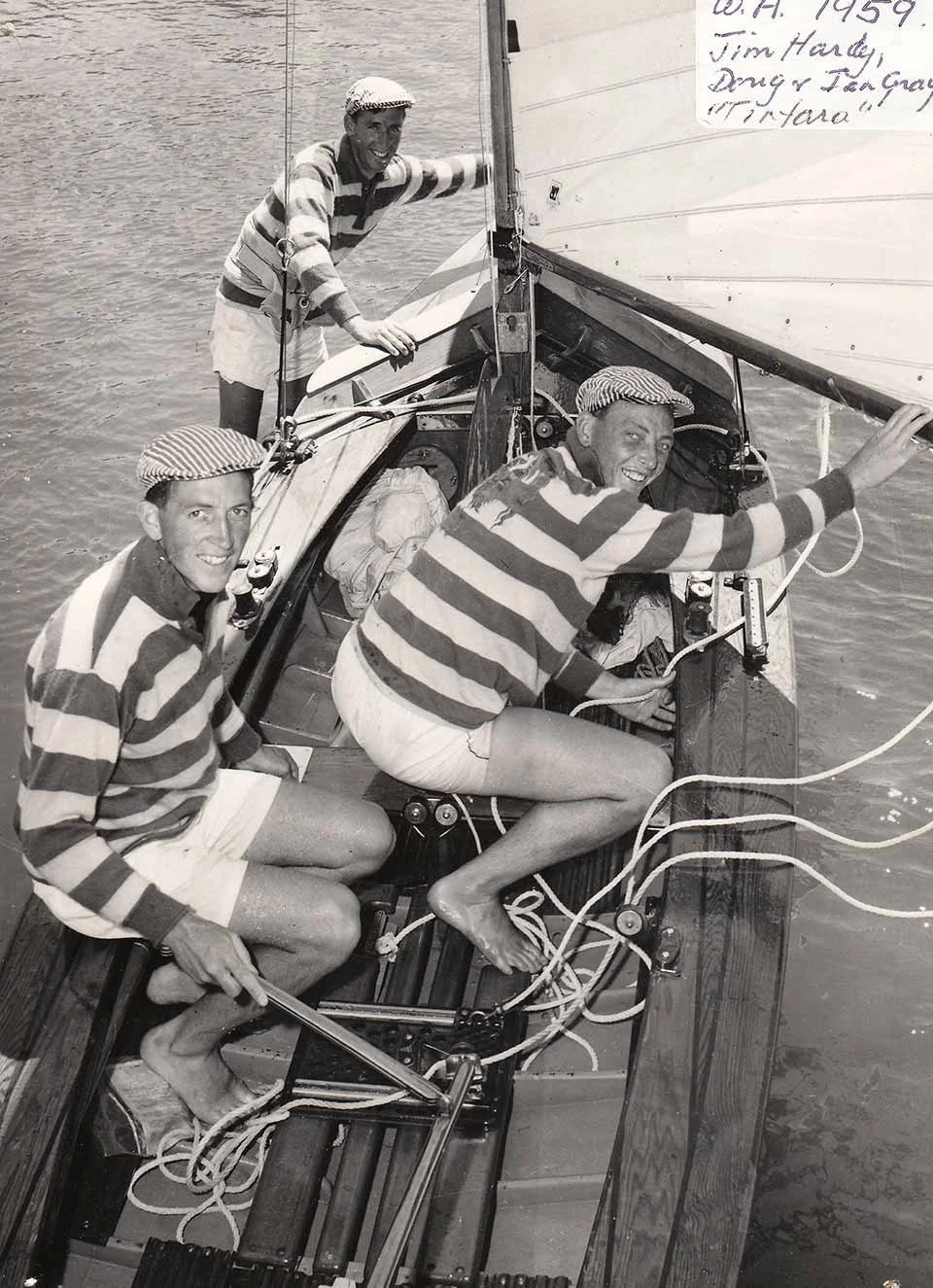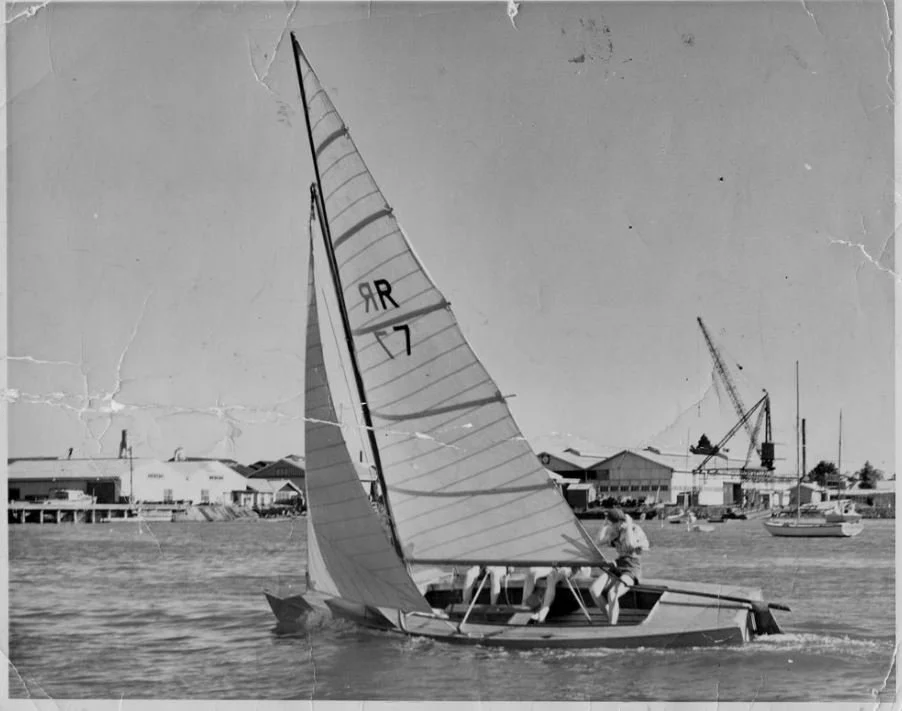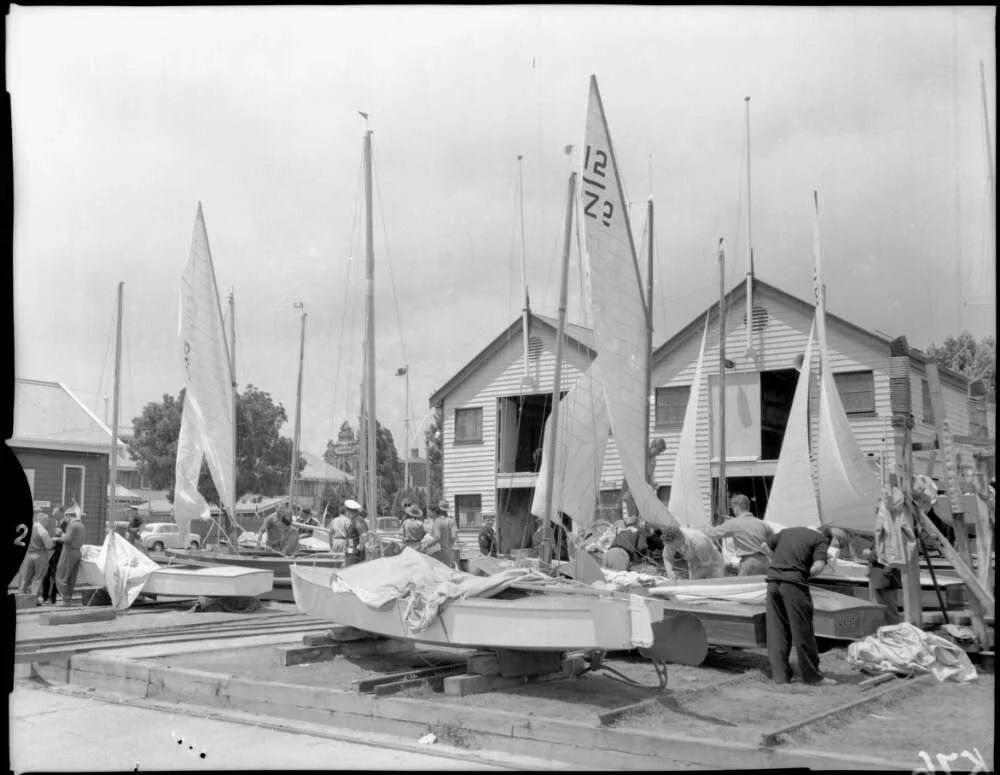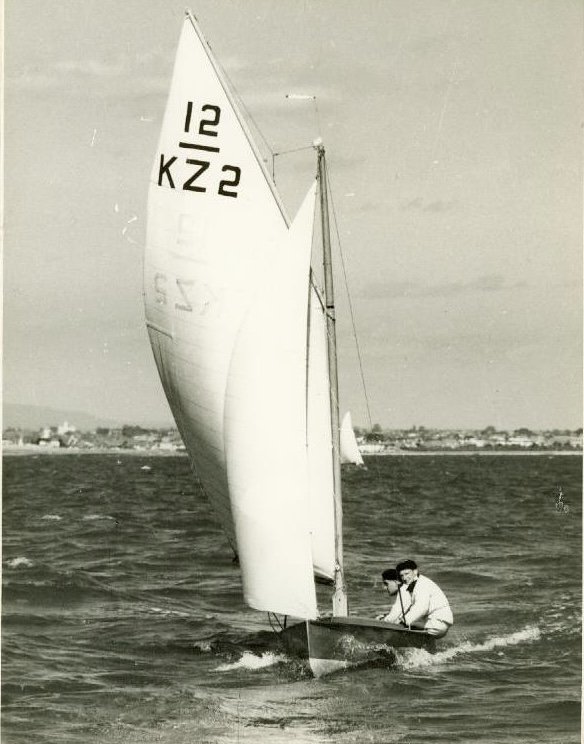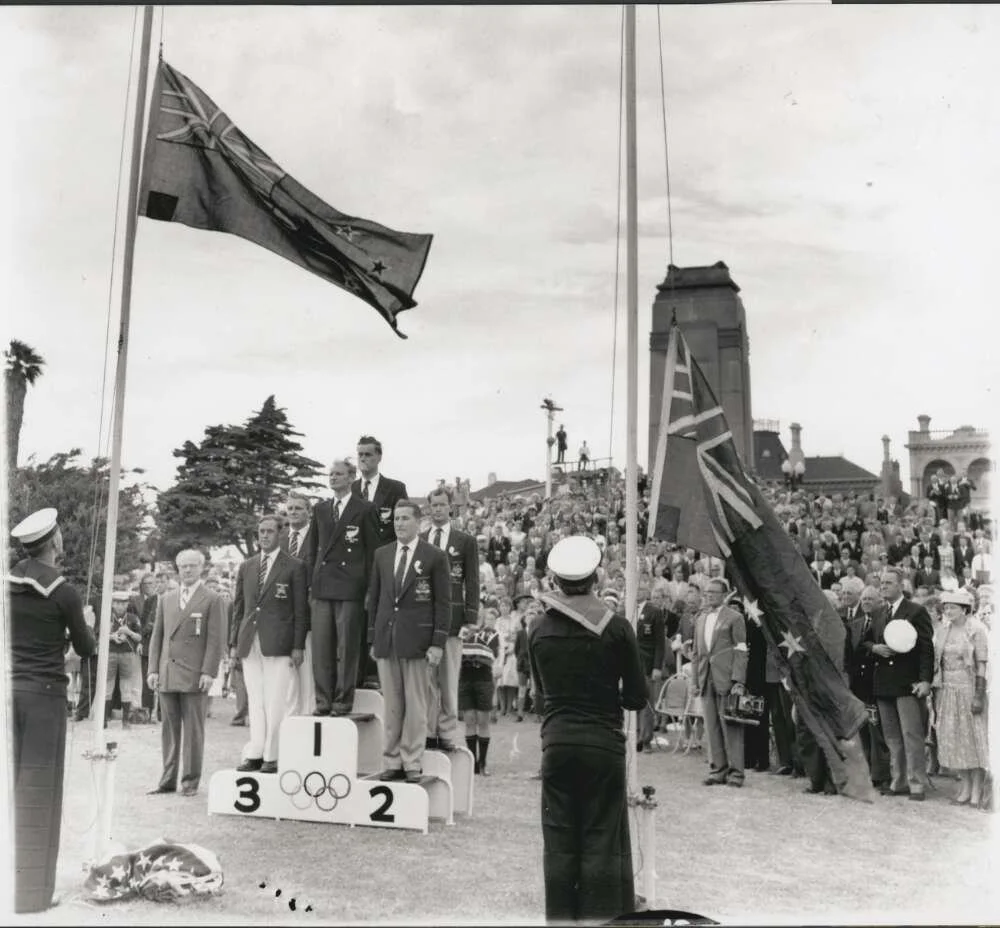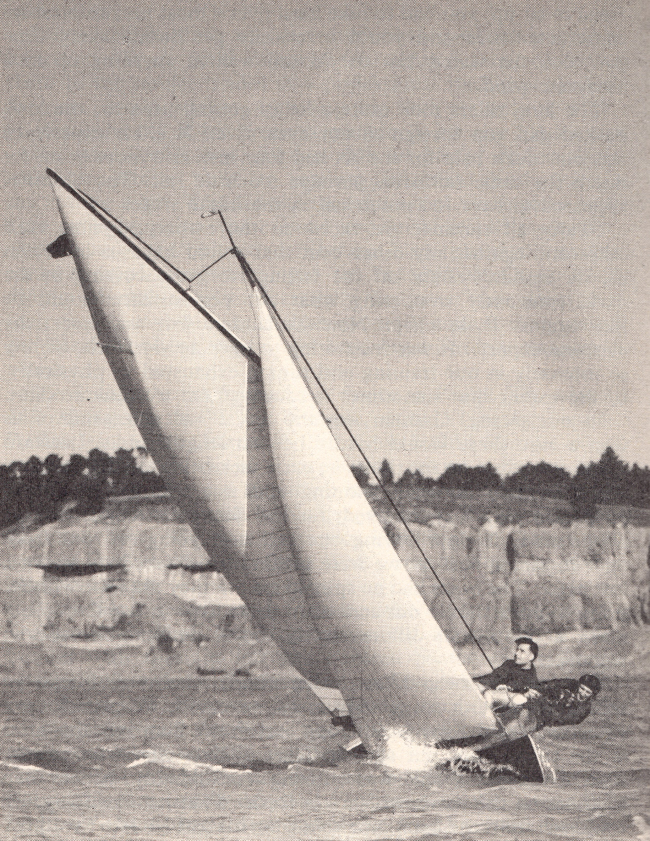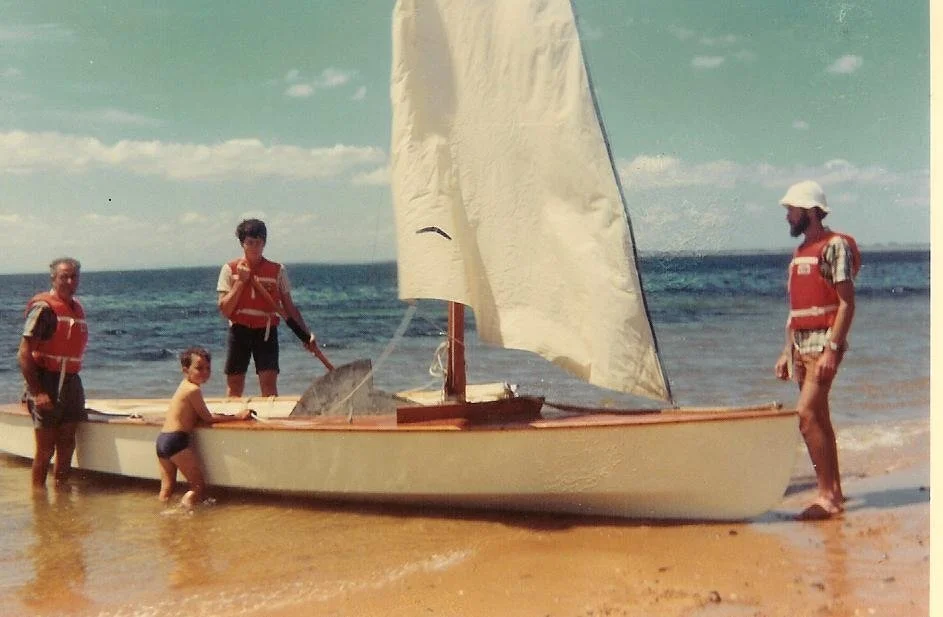The Sharpie Story - Finding Sabre
by Gordon Stewart with SWS
Sharpies have always Attracted A Following. They were 1960’s working class street gangs with flash style and tough attitude. They were also fast Dinghies.
Melbourne’s own West Side Story was Romper Stomper, a movie made in Footscray and Spotswood, right next door to the Royal Yacht Club of Victoria in Williamstown. The club had its own fleet of Sharpies in the 1950’s and hosted the Olympic Sharpie regatta in 1956.
The International 12 Square Metre Sharpie was one of the most influential dinghies of the 20C. It followed a trend towards one-design yachts. The German Kroger brothers designed her in 1931 and the dinghy quickly developed fleets throughout Europe, in particular Germany, Holland and the UK, where they are still sailed today. Its highpoint was selection as the two-person dinghy for the 1956 Olympiad in Melbourne.
Jim Hardy sailing Sharpie TINTARA in Adelaide 1955. Those “paddy caps’ have definite Sharpie style. Photo NLA
The Sharpie is long and narrow at 19’ 7” x 4’ 8” with a Gunter rig carrying 130 Sq ft (12 Sq m) of sail. She’s commonly called the Heavy Weight Sharpie at 500 lb (230kg). Boats still racing in Europe continue to adhere strictly to the original rules of the International Class Association.
The first Australian Sharpie was built in Adelaide 1934 and soon spread to other states. By 1935 and typical of antipodean sailors, we were departing from the International Class Rules. The metric dimensions were converted to imperial, substitute species for oak and mahogany were found, then full length mainsail battens, a spinnaker and an extra crew were added. Chris Thompson of SailCraftblog notes;
The Sharpie quickly became the most widespread dinghy class in the southern states, where the conditions were often too rough for the skiff types that had dominated Australian dinghy sailing. (click on images to enlarge)
South Australia
South Australian fleet c1950’s. Photo: Stewart archive
Western Australia
The Swan River had big Sharpie fleets. Here’s one holding starboard and windward position in Adelaide 1960. Glenelg Town Hall behind. Photo: Stewart collection
Victoria
Off-the-beach sailing clubs around Port Phillip Bay had Sharpie fleets. They were sailed from Frankston, Mornington and Mordialloc, known as the Mordialloc 12 Square Metre Sailing Club. The strongest fleet was at Black Rock SC. They were know for colourful characters and colourful boat names that continued after transition to Lightweight Sharpies like LONG PRONG, PORK SWORD, the GOOD the BAD and the UGLY. These names are probably not quite PC today and even then were more common to muscle ski-boats on Lake Mulwala.
Sharpie fleet in Hobsons Bay c1950’s with the Palais Theatre St Kilda on the far shore (still a sailing reference). Photo: NLA
Tasmania
A copy of the rules published in 1956 has the term ‘International’ removed indicating the recognition of the ‘Australian’ 12 Square Metre Sharpie as a separate and unique class to the International original. By this stage administration of the class was being controlled by the Australian 12 Square Metre Yachting Council.
Despite the differences noted above, the hull shape and dimensions have remained constant. The modern Australian Lightweight Sharpies still share near identical hull offsets as the 12 Sq m Heavyweight design from 1931. In the decades since the introduction of the class in South Australia there were some additional minor structural differences adopted and boats added buoyancy tank bulkheads and trapeze. (click on images to enlarge)
Sharpie plan & profile. Construction drawings Kroger Brothers. Image courtesy RYCT
Olympic Dinghy
The Olympic host country has a say in boat selection. By the time of the Melbourne Olympics, the Australian Sharpie was one of the most popular dinghy classes in the country. There were more than 400 boats actively racing in the 1950-51 season. Despite the class being dominated by the Dutch in Europe, the Sharpie was an obvious choice. In anticipation of the Olympiad, at least three new Australian boats were built to comply with the International Rules. Jim Hardy built TINTARA in Adelaide. Rolly Tasker built FALCON IV in Perth and another was built for RSYS. The fancied Dutch boycotted the event to protest the Russian invasion of Hungary. Tasker represented after winning the Nationals four times between 1952 and 1955 in FALCON III.
Tasker and Huck Scott sailed a terrific regatta. They gained a second place behind Britain in the last heat to finish with a clear points lead and looked the gold medal winner. But a French protest, on the grounds of interference, was upheld and Tasker was disqualified. This left FALCON IV with silver behind JEST, the Kiwi boat built and helmed by Peter Mander and crewed by Jack Cropp. For a boat with such European pedigree, it became an empire triple with Jasper Blackall and Terry Smith from Great Britain sailing CHUCKLES to bronze. See special signal from Terry’s son Roger in messages below. (click on images to enlarge)
Olympic Sharpies rigging in the western yard at RYCV Williamstown. The local Sea Scouts were assigned to help the crews. KZ2 is JEST the gold medalist. Photo NLA
NZ sailing team enjoying T/A lunch boxes and a cuppa in front of Royal St Kilda Yacht Club (now RMYS) before the regatta. L to R: Peter Mander, Frank Simpson, Jack Cropp. John Gillingham, Bert Cuthbertson, Edgar Swinnerton and Bob Stewart. Stewart, Simpson and Cuthbertson were the Dragon Class crew. Photo: NLA
Extras: Catering for the 1956 Olympics was coordinated by Tom Carlyon of St Kilda’s Esplanade Hotel (‘The Espy’ across the road from this photo). His grandson is a Tumlaren sailor at RMYS.
Peter Mander and Jack Cropp sailing JEST off St Kilda. Olympic regatta 1956. Photo: NLA
Medal ceremony in Catani Gardens in front of Royal St Kilda YC (now RMYS). Photo: NLA
After the 1956 Olympics the Sharpie remained a popular class, but was soon technically outdated. Modern lightweights like the Flying Dutchman took over and became the two-person dinghy for Rome 1960. John Cuneo from Queensland won the Sharpie nationals in 1956, ‘58 and 1960 in DARING. Cuneo went on to win the first Australian gold medal sailing Dragon WYUNA at the Munich Olympics 1972. Jim Hardy in TINTARA won the 1959 nationals in Perth.
Rolly Tasker continued to demonstrate the depth of his sailing skills becoming Flying Dutchman world champ in 1958 and a successful offshore racer. He is well known for building an eponymous sailmaking empire, that still operates with a huge loft in Bangkok. The good news for classic dinghy enthusiasts is that Mander’s JEST is having a make-over in NZ, Tasker’s FALCON IV is being restored in Adelaide and CHUCKLES has been restored and is sailing in the UK. Jim Hardy’s TINTARA is at the SA Maritime Museum.
Just as it seemed the class was destined for obscurity, a group of Western Australian Sharpie sailors came up with the idea of building a lighter version to the exact shape and measurements with plywood. The new lighter ply hulls proved significantly faster than the older planked hulls. Initially owners simply transferred their Gunter rigs to the new hulls but within a season, most were carrying Marconi rigs. This is the ‘Australian Lightweight Sharpie’. By 1962, the old planked 12 Square Metre boats became known as ‘Heavyweight Sharpie’ The last National Championship with both HW and LW boats competing together was sailed that year in Hobart.
Combined fleet of Heavyweight and Lightweight Sharpies at the 1961-62 Australian Championships, Hobart Tasmania. The last time both fleets sailed together. Photo: Daryl Ridgeway
Sharpie Lineage
The best analysis of dinghy design and the importance of the 12 Square Metre Sharpie is by Chris Thompson in his SailCraftblog. With apologies to Chris, here’s a few of his insightful notes;
The early 1930s saw the creation of some influential German one designs; classes that have not only influenced dinghy design but also thrive today. The class that had the most widespread influence was the 12 Sq m Sharpie. It was one of three designs entered by brothers Karl and Hans Kroger and their boatbuilding partner Walter Braur into a design competition in 1931 for a new German youth class. Like many German classes, the Sharpie was designed as a cruiser-racer, stable enough to be slept aboard and also to be moored, as there was often little space to pull a boat ashore on the crowded German lakes.
The Kroger Braur team managed to give the Sharpie a beautifully efficient hull. It had a flatter hull with less rocker and vee, a fine slab-sided bow and the BMAX well aft. Like many sharpies, the design had a flat area running along the keel, a development that round-bilged boats only picked up decades later.
Like any Renjolle style boat, one of the 12 Sq Metre’s secrets is simply lots of length and slender shape. It’s one of the longest dinghies of all at 5.9m, yet it has a maximum beam of just 1.43m. It’s long slim shape and vertical topsides mean that its bow was finer than most contemporary boats and later performance boats like the 5o5. Yet the waterlines at the bow are fairly straight, rarely taking on the hollow lines that are generally considered to be slow.
Magic Numbers
Chris Thompson’s magic numbers are length, displacement, beam and righting moment. Take length applied to the Sharpie;
In dinghies and skiffs, just as in yachts, more length equals more speed upwind and around the course. It’s been recognised for a long time. Length, wrote Olympic gold medalist and 18 footer champion Peter Mander back in the ‘50s, is ‘not quite everything. Say ninety-nine percent’.
And Chris on gaff technique;
The Sharpie carried a Gunter rig with nominal area of 137 sq ft (12.7m) including an overlapping genoa. There was no spinnaker, but the big headsail and long pole keep the boat moving downwind. In the 1950s, the hot Dutch fleet realised that they could get more speed by dropping the gaff back about 30 degrees and lowering the boom. The extra area was said to increase performance, but today one wonders whether it wasn’t the more vertical leach that helped.
Peter Mander sailing JEST, the 1956 Sharpie gold medal winner, learnt to ease his gaff aft to de-power the main, in the same way as a bendy mast works.
Peter Mander practicing gaff angles on JEST in NZ. Photo: Stewart archive
The First Stewart Sharpie
My father was brought up around boats in Scotland between the two world wars. The family lived in a cottage on the western shore of the Clyde. He and his brothers spent much time sailing on the river in small boats. My mothers family were all North Sea fishermen from Aberdeen. After serving in the Royal Navy during WW2, my parents immigrated to Chicago. After six years they moved on to Australia arriving in Sydney on 26th January 1959* and settled in Melbourne. I was born soon after. We eventually moved to a house in Frankston fronting Kananook Creek behind the beach on Port Phillip Bay, where many small shipwrights operated.
Once settled, Dad sought to introduce sailing to my two older brothers and me. One day when I was about four years old, my father and brothers came home with a strange, rather long narrow and very neglected looking boat. I was soon to learn that this strange craft was called a ‘Sharpie’. Picked up from a paddock, it was bare grey weathered timber. After months of work by my father and brothers our Sharpie was restored to become the family boat. It arrived unnamed and remained that way.
My father did his apprenticeship as a stonemason in Scotland but was a highly skilled craftsman in all manner of tasks, especially anything to do with boats. For example, the Sharpie came without sails so dad found a set of second hand Rolly Tasker 5o5 sails for sale. Serving as a signalman in the Royal Navy, required him to make and repair ships flags and other canvas goods. Using these skills, he promptly recut the sails to fit the Sharpie’s Gunter rig and then expertly restitched them by hand. The 5o5 is Bermuda rigged with 40 sq ft more sail area and half the weight of a Sharpie. Like most people from that generation, my father from humble beginnings and brought up through the depression years, was known for being very frugal and resourceful. It seemed like he could make anything from the most primitive of tools and scarcest of materials.
Although the Sharpie was clearly designed as a racing boat, dad had no interest in competing. Every summer we would tow the boat to a Phillip Island holiday rental house. The Sharpie would be loaded to the gunwales with the supplies that would sustain the family through the holiday period whilst we jammed ourselves in the family car.
The family Heavyweight Sharpie at Phillip Island Victoria c1968. The swimsuit model is a much younger me! Photo: Stewart Family Collection
The Sharpie was simply used for sailing fun and quite often for fishing. We would troll for couta’ on the way out then drop the sails at the desired fishing spot and mostly catch flathead. As a very young boy I never remember there being a lack of space on the boat. At the time, I actually felt like the Sharpie was enormous! Now that I’m in my late 50’s and have my own Sharpie, I just can’t believe how we managed to fit the four of us in the boat with the gaff, boom and sails stowed down the centre of the cockpit and still find room to comfortably catch fish!
As my brothers grew older and found other interests and spent less time at home, the Sharpie became quite difficult for my father to manage. Particularly when launching and retrieving. A Sharpie is VERY heavy! Sometime in the mid 70’s the Sharpie was sold and dad moved on to more practical and lighter powered craft. I was probably in my early teens but still drawn to sailing. One summer I worked every day for about four weeks labouring for my bricklaying father and two brothers to save enough money to buy a clapped-out Gwen 12. The Gwen’s sail number was 19 so it must have been a very old boat. A Gwen wasn’t the greatest choice for a novice like me but she needed a lot of work, so in that sense, I learnt a lot about boat maintenance in those early days of boat ownership. She was unnamed so I called her BLACKADDER after my father’s first boat on the Clyde.
Sailing Between Sharpies
Although I had become a very sailor, I never had the opportunity to race until I joined the Royal Australian Navy as an apprentice shipwright in 1980. I enlisted three days after my 16th birthday and served nine years from 1980 to 1989. During that period I was very fortunate to participate in racing in my own boats and also in the RAN sailing scene. It did take a lot of effort to fit in sailing whilst serving with THE GREY FUNNEL LINE (the sailors name for the Navy).
Being in the Navy demands a fair amount of time at sea and moving around with no real home base. This brought both advantages and disadvantages to my sailing experiences. The constant moving around made it difficult to settle into a particular class or club. But it did allow me to gain a lot of experience in many classes on different waters and experience a wide variety of venues nationally and internationally. During those years I sailed in a 16ft Skiff, Rainbow, Bosun Dinghy, Vee Ess, Javelin, Impulse, Tasar, 470 and Laser. I competed in half a dozen State Championships in the Impulse (Vic & NSW), one National Championship in the Vee Ess, one State and one National Championship in the Rainbow and the 1988 Olympic trials in the 470. I sailed State, National, European and then three World Championships in the Tasar class, including one of the Worlds with my wife Bernadette. I also managed to fit in some offshore racing with the ORCV circuit including a Melbourne Hobart race in 1968.
Gordon Stewart sailing his Impulse ARIEL during the 1986 NSW Stae Championship at Sutherland Shire Sailing Club. Photo: Stewart Family collection
After discharging from the RAN in 1989, we settled in Melbourne where I continued my racing for a short while in a Laser while crewing on a Fireball out of Frankston Yacht Club. It was at about this time that our second child was born and we made the move to Hobart. Apart from the odd crewing position on Lightweight Sharpies on the Derwent, we introduced our kids to Mirror sailing. My sailing really took a back seat until 2014 when I found myself with a bit more time on my hands after the kids had grown up and moved on with their own lives.
A Second Stewart Sharpie
I don’t remember exactly what drew me to the idea of finding an original 12 Square Metre Sharpie but it was no doubt a bit of nostalgia around my early family sailing. I stumbled on some internet photos and videos of Sharpies sailing in Europe. With my boatbuilding skills and newly found spare time, I figured there must be an old Heavyweight Sharpie out there needing restoration.
Gordon’s story of finding the early Tasmanian Sharpie SABRE on Lake Albert at Wagga Wagga as #83, her restoration and relaunch with the original #38, has a nice symmetry and will be published as Part 2 of ‘The Sharpie Story’.
SABRE #83 on Lake Albert, Wagga Wagga NSW 1970. Sail logo is crossed sabres on red shield. Gotta love the period tablecloth and Dymo labels. Photo: Stewart Archive
Credits
The author Gordon Stewart lives in Hobart and sails his 12 Sqm Sharpie SABRE from Port Cygnet Sailing Club.
All photos are from Gordon’s archive. SWS has attributed where possible. The source of many images is a work ‘on progress’
Chris Thompson writes SailCraftblog. Quoted from Pt 1.28 The German One Designs and Pt 2.1 The Numbers Game.
See Wistari Facebook 9 June 2021 for 1938 - 2016 Sharpie Legends
Thanks to Milton Green for extra notes about Victorian Sharpie clubs.
*26th January is Australia Day to mark the landing of the First Fleet in Botany Bay NSW in 1788. It is now a properly contested matter by First Nations Australians. The States have only marked 26 January since the 1930’s, previously preferring their own founding days.
For 150 years these dates have been celebrated with sailing regattas. For old sailors this was always ANA long weekend. That too has been dropped as it refers to the Australian Natives Association, a group that promoted the ‘White Australia” policy abolished in 1966. SWS Ed.

